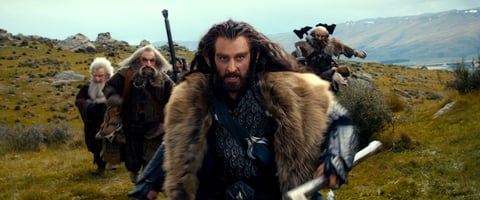To 3D Or Not To 3D: Buy The Right Hobbit Ticket

The Hobbit and The Lord of the Rings were made by the same people and are set in the same world, but there are a good number of things that set them apart. The first series was based on three books that had to be edited to fit into three movies, and the new trilogy is based all on a single book that has been expanded. Lord of the Rings is an epic tale of war, battle and struggle, and The Hobbit began as a tiny story that J.R.R. Tolkien used to tell his children.
But perhaps the most significant point of contrast between Peter Jackson’s old trilogy and new is the way in which in which the movies were made. Taking a few big technological steps forward, the Kiwi filmmaker decided to not only make The Hobbit movies at a faster frame rate, but also in 3D. And just as we ask the question for every other 3D movie, we now ask it for The Hobbit: An Unexpected Journey: is it worth paying the few extra bucks to see?
Below you will find a full breakdown and rating of the movie’s attributes and utilization of 3D to determine whether or not it is the proper way to view the film. Should you pay the additional $4 for the different experience? Find out below!
NOTE: This 3D review is based on a screening of the movie that was in standard 24fps rather than 48fps
Does It Fit?
Outside of animated films, it’s typical that the best 3D you’re ever going to find is in massive, CGI-aided action titles, and in this respect The Hobbit: An Unexpected Journey certainly qualifies. Because of the sweeping epic quality of the movie, which includes many long, aerial shots of Middle-earth’s beauty as the main characters trek along, as well as a few big battle scenes, there are many parts of the film that demonstrate why 3D and Tolkien should be a great fit. All that said, I did take off one point from the score because The Lord of the Rings series wasn’t made in 3D, and the format change does have a clear aesthetic effect that distances the new from the old.
Fit Score: 4/5
Planning & Effort
Your Daily Blend of Entertainment News
Sure, Jackson didn’t make the Lord of the Rings movies in 3D, but it was in the conversation about The Hobbit a long time before cameras started rolling (before the project got the green light, even). The film was made in native 3D, and Jackson even went on record during production saying that his decision to film at 48fps was largely motivated by the desire to make the 3D clearer, working to eliminate strobing and blur that’s caused when the cameras are moving and create a sharper, more brilliant picture. It’s still up for debate whether or not 3D is the best way to watch The Hobbit (keep reading!), but the planning and effort is unquestionable.
Planning & Effort Score: 5/5
Before the Window
When you consider how much time and energy went into the 3D, it’s actually disappointing how little the movie takes advantage of the “Before The Window” aspect of the technology – a reference to how the movie plays with objects that seem to be coming out of the screen towards the audience. There is some exception, as the film isn’t completely devoid of things popping out at the audience, but it’s clearly not Jackson’s primary use of the format. Between random debris from the environment, changing weather patterns, and the fact that characters are tossing around arrows and spears and such, there is plenty of opportunity presented for 3D, but it’s rarely taken advantage of. Hopefully it will be something we get to see a bit more of in the second and third movies.
Before the Window Score: 2/5
Beyond the Window
Because Jackson’s focus is clearly not on making things appear to be coming out of the screen, all of his focus is instead paid towards capitalizing on depth, and in this department he hits a home run. Long shots of Bilbo and the company of dwarves making their way across the land is amazing enough, as you feel like you could fall into Middle-earth, but where the director really shows off his skills is in more personal, intimate areas. Whether it’s Bilbo’s cozy little Hobbit hole or Gollum’s cave in the Misty Mountains, Jackson uses the stereoscopic camera to really explore the settings and make the audience feel like they are totally immersed in the world.
Beyond the Window Score: 5/5
Brightness
Going back to the book, probably the most famous scene in The Hobbit is when Bilbo Baggins and Gollum are having a game of riddles in a deep, dark, dank cave – and the way that the movie pulls it off with the 3D is actually quite brilliant. While brightness has always been the biggest issue with the medium, due to the fact that it requires audience members to essentially wear sunglasses indoors, Jackson’s latest film doesn’t make it a problem. Some of the most climactic parts of the story happen at night or indoors, but the 3D never creates an obstruction, and the same can be said for daytime/outdoor scenes, which aren’t muddled or greyed out. A poor projectionist probably has more impact on this category than any other, but if you see The Hobbit in a quality movie theater then brightness definitely won’t be an issue during your viewing experience.
Brightness Score: 5/5
The Glasses Off Test
The reason one needs 3D glasses to watch a 3D film is because the format is created by filming two separate images that are only combined once looking through a pair of lenses that combine the images. If the lenses are removed, however, what you see is a blurry mess – as your eyes can’t properly process what they are seeing – but more importantly, the more blur there is, the more levels of depth there is to perceive. During my screening of The Hobbit I peeked over the rim of my 3D glasses more than a few times and what I saw was a mostly-positive mixed bag. While some scenes were surprisingly and disappointingly clear (namely the shots that didn’t really have a great opportunity to make the best of the use of the technology), for the most part the film was unwatchable without the help of the lenses.
Glasses Off Score: 4/5
Audience Health
This is an interesting subject to tackle, as previously mentioned I only saw the movie in 24fps rather than 48fps. While there have been some who have complained of dizziness and nausea as a direct result of the faster frame rate, walking out of The Hobbit I felt perfectly fine – which is impressive if not just because of the movie’s extended length. Jackson maintains his focal points well, preventing the audiences’ eyes from drifting too much and causing discomfort. Just like every other time we write about this subject, it’s important to mention that this category is a bit more subjective than some of the others, but I can honestly say I walked out of my screening feeling 100%.
Audience Health Score: 5/5
| SCORES RECAP | |
| 3D Fit | 4 |
| P&E | 5 |
| Before The Window | 2 |
| Beyond The Window | 5 |
| Brightness | 5 |
| The Glasses Off Test | 4 |
| Audience Health | 5 |
| Total Score | 30 (out of a possible 35) |
Final Verdict: Peter Jackson made The Hobbit: An Unexpected Journey to be seen in 48fps and in 3D, but it’s definitely something you should weigh before purchasing your ticket. As a 30 out of 35 indicates, the movie uses the technology well, but it’s not perfect, and purists may want to see the Hobbit movies the same way they saw the Lord of the Rings films – in regular old 2D. Having seen the film I will recommend the 3D experience, but this is one title that requires you to make a determination based on something beyond the final score.
This poll is no longer available.

Eric Eisenberg is the Assistant Managing Editor at CinemaBlend. After graduating Boston University and earning a bachelor’s degree in journalism, he took a part-time job as a staff writer for CinemaBlend, and after six months was offered the opportunity to move to Los Angeles and take on a newly created West Coast Editor position. Over a decade later, he's continuing to advance his interests and expertise. In addition to conducting filmmaker interviews and contributing to the news and feature content of the site, Eric also oversees the Movie Reviews section, writes the the weekend box office report (published Sundays), and is the site's resident Stephen King expert. He has two King-related columns.
